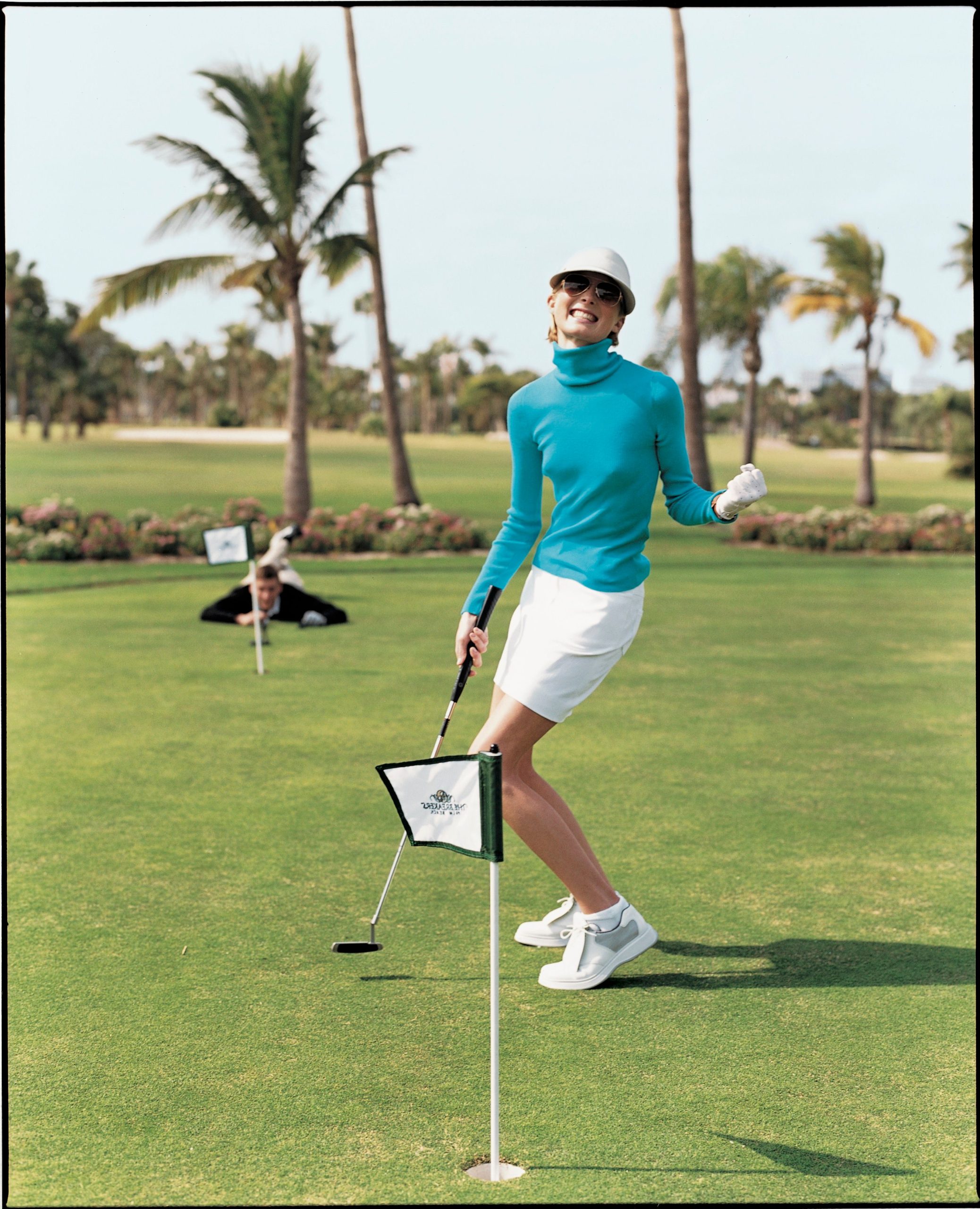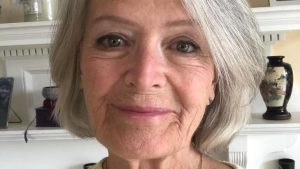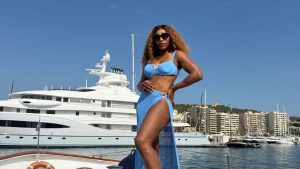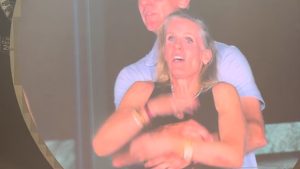
More Women Are Booking Golf Trips—and the Travel Industry Is Taking Note
Photographed by Arthur Elgort, Vogue, November 2002
All products featured on Vogue are independently selected by our editors. However, we may receive compensation from retailers and/or from purchases of products through these links.
Golf’s image has traditionally been skewed one way: an older man in a collared shirt and khakis, clubs in hand, ready for an afternoon on the green. But that’s changing. Since 2019, female golfers have seen a 41% increase, according to the National Golf Foundation—and women now make up 28% of on-course golfers, the highest on record. This increase has the travel industry taking note. “Female participation at Monarch Beach Golf Links has seen a notable increase, particularly in lessons and group events,” says Jackie K. Riegle, PGA, director of player development and marketing at Monarch Beach Golf Links, who personally leads many of the sessions and coaches at the resort. “This growth is fueled by a broader movement toward inclusivity in golf and a rising demand for social and wellness-focused experiences among women.
Riegle isn’t alone in observing this rise. From California to Fiji, courses and resorts are seeing more women teeing off—not just as casual weekend players, but as intentional travelers building getaways around the sport.
For Kelsey Ogletree, founder of Pitchcraft and lifelong golfer, golf isn’t just a sport—it’s a foundational part of her identity. Introduced to the game by her father at age three, Ogletree played competitively in high school and college, and now incorporates golf into many of her vacations.
“We regularly planned vacations around golf destinations,” she says of trips with her husband. “Scottsdale and Tucson were favorites, and we also enjoy playing in Mexico—El Camaleon in Mayakoba, which hosts PGA [Professional Golfers’ Association] Tour, LIV, and LPGA [Ladies Professional Golf Association] tournaments, is one of our favorites.” This summer, Ogletree, now eight months pregnant, is planning a golf trip to McLemore in Georgia before the arrival of her second child. (“Yes, I’m still swinging at eight-plus months pregnant!”)
Her approach to golf travel? It’s less about shooting under par, and more about balancing experience. “We like to golf for a day or two, but not every day of our trip.” She notes that mixing in things like nice meals at new restaurants, lounging by the pool or beach, or exploring the town is essential—it’s not just about golf.
That lifestyle-centric attitude reflects a broader shift in how women are approaching the sport. Taylor Olson, founder of women’s golf fashion brand Draw & Fade, sees this trend as both exciting and overdue. “Just two years ago, my mom and I were asked to leave an outdoor area of the ‘men’s grill’ at a club,” Olson recalls, making note that there were no other similar spaces for women players. “We still live in the age of ‘men’s grills’ and that contributes to the intimidation factor that I think deters so many women from playing the game.”
Still, Olson believes the fashion and community boom has played a key role in making golf more approachable for women—and it’s an important part of why she created her brand. “There are so many more apparel options now that make women feel confident and comfortable on the course. For me, it’s helping remove the intimidation factor on the course for women and helping them feel a sense of belonging,” she says. “That starts with the clothing options available to women because historically the options were fairly limited in terms of colors, fabrics, styles, et cetera, and just overall gave the feeling that they were made for a spectator versus a player in mind.”
She’s hopeful the industry will continue to catch up—and not just in terms of style. She notes organizations like Fore the Ladies and personalities like Tori Totlis are helping create spaces where women can learn and travel together for golf. Olson wants to see tee boxes continue to be noted by skill level rather than gender, more inclusive pro shops, and the elimination of gendered course signage altogether. “[This] will only help usher in more female players and make every female player feel supported,” she says.
As more women golfers travel, resorts are adapting. Kim Cassett, a retail marketing senior manager at Callaway and an LPGA member, sees the shift from both inside the industry and on the greens. “Ever since COVID, we’ve seen an incredible number of women enter the game,” Cassett explains. And that rise will only continue—she notes the surge in junior female golfers, for example.
Callaway has responded with product lines like REVA Rise, which includes golf clubs designed specifically for female players. But Cassett believes experience matters as much as equipment. “For new golfers, I always recommend starting at a local driving range,” she says. She then recommends going in this order: private lessons or group clinics with friends, before an executive golf course, and finally, playing a full-sized, 18-hole course. “For women who are comfortable enough playing with others, I highly recommend grabbing your friends and going on adventurous, destination golf trips,” she says. “Properties like The Broadmoor, Sea Island Resort, and Bandon Dunes offer memorable experiences that last a lifetime.”
Callaway even co-hosts a women’s golf event at The Broadmoor—a blend of equipment education, social connection, and skill-level play. “It’s a very warm and welcoming event that celebrates women from all skill levels,” Cassett says. (And the next one will be even bigger in 2026.)
At The Biltmore Hotel Miami-Coral Gables, PGA director of golf Lara Pavloff is making sure women don’t feel like an afterthought. “Golf is already intimidating. It can be even more so for women,” she says. “As a female director of golf and PGA Golf Professional, I have an obligation to ensure we have a female-friendly golf experience. We want women to come here and feel comfortable.” She notes that Biltmore has a large selection of women’s apparel (with on-trend brands) and that women’s programming is top of mind, including women’s-only tournaments. (They’re also the home facility and course for the University of Miami Women’s Golf Team: “Watching those women hit the golf ball is even more inspiration for little girls learning the game,” she says.)
Pavloff suggests looking for key indicators when choosing a resort: looking to see if they offer women’s clubs for rent, looking at the signage to see if it’s by skill level and not by gender, and seeing if there are any female-led programs or visibility on staff. She also encourages every beginner to sign up for a lesson. You’ll not only learn about how to play golf on the course, but you’ll also learn the etiquette, which can often make new players weary. “Etiquette is oftentimes the most intimidating part of golf, no one wants to appear like they don’t know what they are doing,” she says.
What makes Biltmore special, Pavloff adds, is the holistic experience and its approachability. “It’s rare to find a high-end property where someone can practice at the golf facilities without committing to a full round or dining at one of the restaurants. In other words, it’s accessible for beginners, which definitely sets us apart,” she says. “And the fact that you can book a golf lesson and a spa treatment in the same place? Win win.”
Golf travel for women isn’t just growing in the U.S.—it’s a global trend. Lachlan Walker, regional general manager for Fiji and Pacific IHG Hotels & Resorts, has seen a rise in female participation at Fiji’s Natadola Bay Championship Golf Course, “especially among leisure guests staying at InterContinental Fiji Golf Resort & Spa,” with many women teeing off while on vacation.
“Golf today is more than a sport—it’s a lifestyle,” Walker says, noting that IHG Hotels & Resorts has designed offerings around that mindset. Whether it’s adding coaching clinics, offering female-friendly gear in the pro shop, or creating seamless resort-course access with shuttles and booking systems, the goal is to make it effortless.
And with scenic backdrops like the South Pacific Ocean, Walker says it’s no surprise women are gravitating toward the game. “It’s physically engaging, socially enriching, and deeply grounding,” he says. “For many, it’s the perfect balance of self-care, connection, and personal challenge.”
With increased visibility of the LPGA, thriving online communities, and brands stepping up with better gear, programming, and marketing, the sport is finally evolving beyond its old image.
Golf trips no longer require a “serious golfer” resume or matching polos—they’re about being active, social, stylish, and maybe even sipping wine at the 19th hole. As more women plan their vacations around tee times, the industry is following their lead—investing in inclusive design, instruction, fashion, and experience.
As Ogletree says, “You can travel with your girlfriends and play golf without calling it a ‘women’s golf trip’—that’s the beauty of it. I think golf travel is much more lifestyle-focused now, so you can play 9 or 18 holes in the morning and afterward go wine tasting, take a hike, hang out on the beach, head to a cool cocktail bar… golf becomes part of the experience, not the entire trip.”











